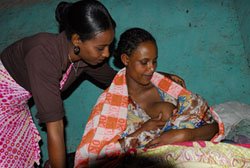
Finally, we turn to the methods of prevention and control of acute respiratory tract infections (ARIs). You need to know about them so you can teach members of your community how they can protect their children and vulnerable adults from acute otitis media, pharyngitis and pneumonia.
Do you remember the difference between prevention and control?
Prevention measures, such as immunization, are applied before the occurrence of a communicable disease to reduce the risk that it will develop. Control measures, such as the treatment or isolation of cases, are applied after the occurrence of the disease, with the aim of reducing the transmission of the infectious agents to new susceptible people.
Prevention measures for ARIs include:

Immunize all children with:
You can help to control the spread of respiratory bacteria by educating parents to avoid contact as much as possible between their children and patients who have ARIs. You should also teach people with ARIs to cough or sneeze away from others, hold a cloth to the nose and mouth to catch the airborne droplets when coughing or sneezing, and disinfect or burn the cloths afterwards. Immunization also increases control, by reducing the reservoir of infection in the community and increasing the level of herd immunity.